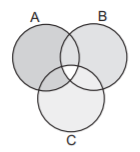11.
Consider the following :
$$\eqalign{
& 1.\,\,A \cup \left( {B \cap C} \right) = \left( {A \cap B} \right) \cup \left( {A \cap C} \right) \cr
& 2.\,\,A \cap \left( {B \cup C} \right) = \left( {A \cup B} \right) \cap \left( {A \cup C} \right) \cr} $$
Which of the above is/are correct ?
A
1 only
B
2 only
C
Both 1 and 2
D
Neither 1 nor 2
Answer :
Neither 1 nor 2
12.
For a set $$A,$$ consider the following statements :
$$\eqalign{
& 1.\,\,A \cup P\left( A \right) = P\left( A \right) \cr
& 2.\,\,\left\{ A \right\} \cap P\left( A \right) = A \cr
& 3.\,\,P\left( A \right) - \left\{ A \right\} = P\left( A \right) \cr} $$
where $$P$$ denotes power set.
Which of the statements given above is/are correct ?
A
1 only
B
2 only
C
3 only
D
1, 2 and 3
Answer :
1 only
13. If $$P\left( A \right)$$ denotes the power set of $$A$$ and $$A$$ is the void set, then what is the number of elements in $$P\left\{ {P\left\{ {P\left\{ {P\left( A \right)} \right\}} \right\}} \right\}\,?$$
A
0
B
1
C
4
D
16
Answer :
16
14. Which of the following sets is a finite set ?
A
$$A = \left\{ {x:x\, \in \,Z{\text{ and }}{x^2} - 5x + 6 = 0} \right\}$$
B
$$B = \left\{ {x:x\, \in \,Z{\text{ and }}{x^2}{\text{ is even}}} \right\}$$
C
$$D = \left\{ {x:x\, \in \,Z{\text{ and }}x > - 10} \right\}$$
D
All of these
Answer :
$$A = \left\{ {x:x\, \in \,Z{\text{ and }}{x^2} - 5x + 6 = 0} \right\}$$
15. The relation $$R$$ defined on the set $$A = \left\{ {1,\,2,\,3,\,4,\,5} \right\}$$ by $$R = \left\{ {\left( {x,\,y} \right):\left| {{x^2} - {y^2}} \right| < 16} \right\}$$ is given by :
A
$$\left\{ {\left( {1,\,1} \right),\,\left( {2,\,1} \right),\,\left( {3,\,1} \right),\,\left( {4,\,1} \right),\,\left( {2,\,3} \right)} \right\}$$
B
$$\left\{ {\left( {2,\,2} \right),\,\left( {3,\,2} \right),\,\left( {4,\,2} \right),\,\left( {2,\,4} \right)} \right\}$$
C
$$\left\{ {\left( {3,\,3} \right),\,\left( {3,\,4} \right),\,\left( {5,\,4} \right),\,\left( {4,\,3} \right),\,\left( {3,\,1} \right)} \right\}$$
D
None of these
Answer :
None of these
16. Let $$U$$ be the universal set and $$A \cup B \cup C = U.$$ Then $$\left\{ {\left( {A - B} \right) \cup \left( {B - C} \right) \cup \left( {C - A} \right)} \right\}'$$ is equal to :
A
$$A \cup B \cup C$$
B
$$A \cup \left( {B \cap C} \right)$$
C
$$A \cap B \cap C$$
D
$$A \cap \left( {B \cup C} \right)$$
Answer :
$$A \cap B \cap C$$
17. The relation $$R$$ defined in $$A = \left\{ {1,\,2,\,3} \right\}$$ by $$aRb,$$ if $$\left| {{a^2} - {b^2}} \right| \leqslant 5.$$ Which of the following is false ?
A
$$R = \left\{ {\left( {1,\,1} \right),\,\left( {2,\,2} \right),\,\left( {3,\,3} \right),\,\left( {2,\,1} \right),\,\left( {1,\,2} \right),\,\left( {2,\,3} \right),\,\left( {3,\,2} \right)} \right\}$$
B
$${R^{ - 1}} = R$$
C
Domain of $$R = \left\{ {1,\,2,\,3} \right\}$$
D
Range of $$R = \left\{ {5} \right\}$$
Answer :
Range of $$R = \left\{ {5} \right\}$$
18. Let $$X = \left\{ {1,\,2,\,3,\,4,\,5} \right\}$$ and $$Y = \left\{ {1,\,3,\,5,\,7,\,9} \right\},$$ which of the following is not relation from $$X$$ to $$Y$$ ?
A
$${R_1} = \left\{ {\left( {x,\,y} \right):y = x + 2,\,x\, \in \,X,\,y\, \in \,Y} \right\}$$
B
$${R_2} = \left\{ {\left( {1,\,1} \right),\left( {2,\,1} \right),\left( {3,\,3} \right),\left( {4,\,3} \right),\left( {5,\,5} \right)} \right\}$$
C
$${R_3} = \left\{ {\left( {1,\,1} \right),\left( {1,\,3} \right),\left( {3,\,5} \right),\left( {3,\,7} \right),\left( {5,\,7} \right)} \right\}$$
D
$${R_4} = \left\{ {\left( {1,\,3} \right),\left( {2,\,5} \right),\left( {2,\,4} \right),\left( {7,\,9} \right)} \right\}$$
Answer :
$${R_4} = \left\{ {\left( {1,\,3} \right),\left( {2,\,5} \right),\left( {2,\,4} \right),\left( {7,\,9} \right)} \right\}$$
19. The Cartesian product of two sets $$P$$ and $$Q,$$ i.e., $$P \times Q = \phi ,$$ if :
A
either $$P$$ or $$Q$$ is the null set
B
neither $$P$$ nor $$Q$$ is the null set
C
Both (A) and (B)
D
none of these
Answer :
either $$P$$ or $$Q$$ is the null set
20. Let $$f:\left\{ {2,\,3,\,4,\,5} \right\} \to \left\{ {3,\,4,\,5,\,9} \right\}$$ and $$g:\left\{ {3,\,4,\,5,\,9} \right\} \to \left\{ {7,\,11,\,15} \right\}$$ be functions defined as $$f\left( 2 \right) = 3f\left( 3 \right) = 4,\,f\left( 4 \right) = f\left( 5 \right) = 5,\,g\left( 3 \right) = g\left( 4 \right) = 7,$$ and $$g\left( 5 \right) = g\left( 9 \right) = 11.$$ Then $$gof\left( 5 \right)$$ is equal to :
A
$$5$$
B
$$7$$
C
$$11$$
D
$$1$$
Answer :
$$11$$
